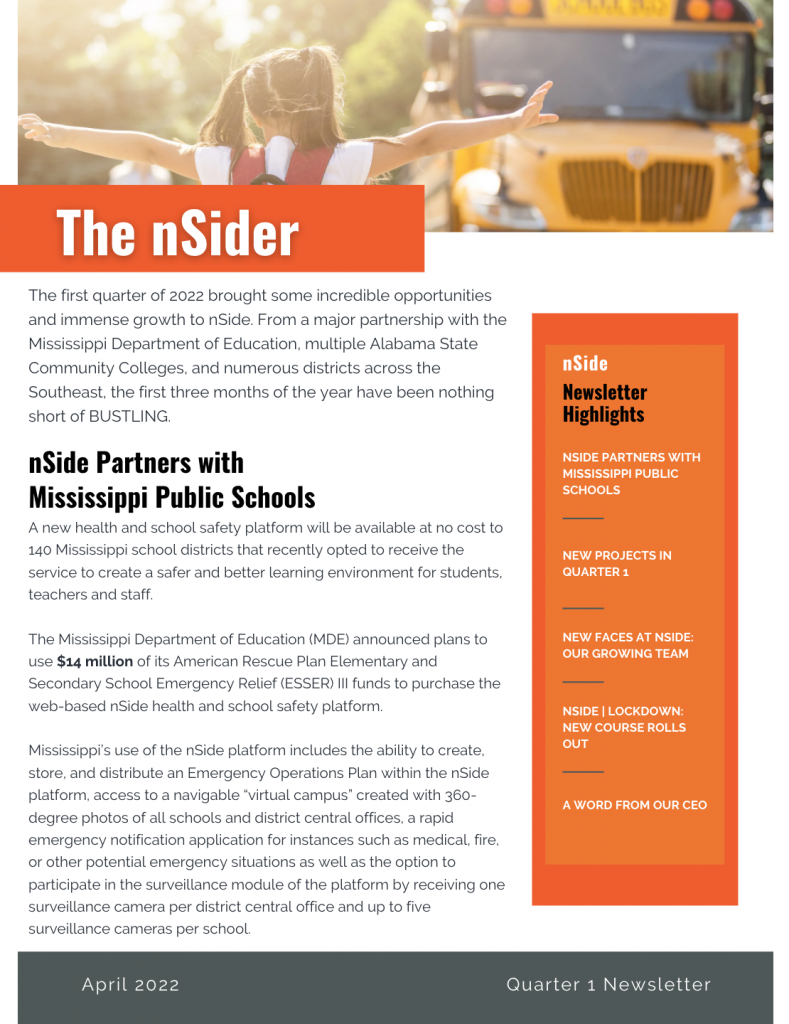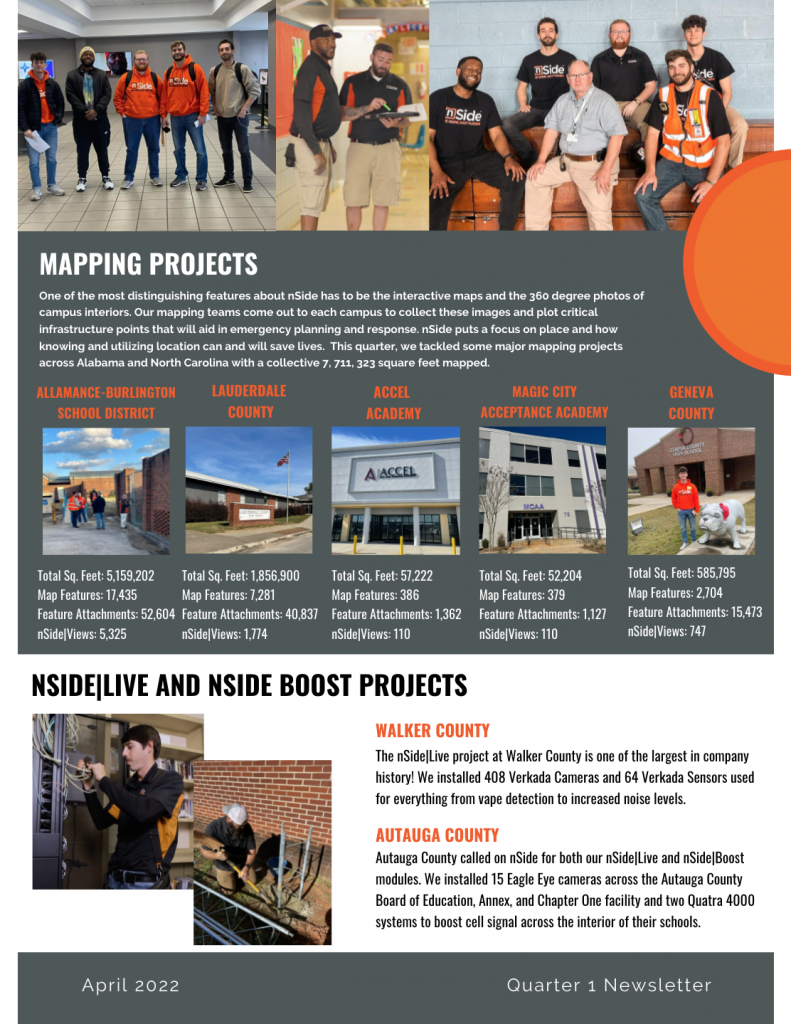nSide Announces Leadership Transition to Fuel Continued Growth
nSide – The School Safety Platform and The “I Love U Guys” Foundation Announce Mission Partnership

In response to the growing concern over school safety and the need for proactive measures to prevent violence, legislatures across the nation are enacting new bills mandating the establishment of behavioral threat assessment teams in schools. These teams, composed of trained professionals, are tasked with identifying, evaluating, and mitigating potential threats to student safety before they escalate into larger situations.
WHAT EXACTLY DO THESE BEHAVIORAL THREAT ASSESSMENT TEAMS DO?
At their core, they employ a multidisciplinary approach to assess concerning behaviors exhibited by students. Through collaboration with educators, counselors, law enforcement, and mental health professionals, these teams gather information, conduct risk assessments, and develop intervention strategies to address underlying issues contributing to the threats.
To break it down, they:
- Identify and Assess Students Posing a Threat to Others or Themselves
- Conduct Risk Assessments
- Gathering, Document, and Report Relevant Information
- Provide Interventions and Support
- Monitor and Follow-Up
WHY ARE BEHAVIORAL THREAT ASSESSMENT TEAMS IMPORTANT?
Lt. Craig Parker, Commander of the Tuscaloosa PD Behavioral Intervention Team, underscores the importance of such initiatives, stating, “We have all witnessed the unfortunate rise of targeted violence in our communities, large and small. Behavioral Threat Assessment and Management initiatives offer us the opportunity to educate our communities, identify and intercept potentially dangerous situations, and proactively mitigate threats through a multiagency, multidisciplinary program. These initiatives have become a vital tool in a holistic approach to community safety.”
Indeed, the significance of behavioral threat assessment teams cannot be overstated. They not only serve as a proactive measure to prevent violence but also contribute to fostering a supportive and nurturing school environment. By addressing underlying issues such as mental health concerns, trauma, and social difficulties, these teams play a pivotal role in promoting the well-being of students and staff alike.
HOW DO I CREATE A BEHAVIORAL THREAT ASSESSMENT TEAM?
Identify Key Stakeholders and Establish a Core Team
Determine the key stakeholders who will be involved in the threat assessment team. This typically includes school administrators, teachers, counselors, school psychologists, social workers, and possibly law enforcement or mental health professionals from the community.
Form a core team of individuals who will lead the development and implementation of the threat assessment program. This team should include internal and external representatives who possess expertise in areas such as mental health, behavior management, crisis intervention, and legal issues.
Develop Policies and Procedures
Develop clear and comprehensive policies and procedures for conducting threat assessments. These should outline the purpose of the team, criteria for identifying and assessing threats, steps for intervention and support, confidentiality protocols, and guidelines for documentation and reporting.
Training and Education
Provide training and education for team members on threat assessment principles, risk factors for violence, mental health awareness, crisis intervention techniques, legal considerations, and cultural competency. Training should be ongoing to ensure that team members stay up-to-date on best practices.
Utilize Assessment Tools such as nSide|Assess™
Utilize standardized assessment tools and protocols for evaluating threats and determining appropriate interventions. These tools should be evidence-based and tailored to the specific needs and characteristics of the school community.
Coordinate with External Resources
Establish partnerships with external resources such as mental health agencies, law enforcement, juvenile justice systems, and community organizations. This collaboration can provide additional support and expertise for assessing and managing threats.
Promote Awareness and Communication
Promote awareness of the threat assessment program among students, staff, parents, and the broader school community. Communicate the purpose and procedures of the program, encourage reporting of concerns, and emphasize the importance of creating a safe and supportive school environment.
Evaluate and Improve
Continuously evaluate the effectiveness of the threat assessment program and make adjustments as needed. Solicit feedback from team members, stakeholders, and participants to identify areas for improvement and ensure that the program remains responsive to the evolving needs of the school community.


nSide|Assess™ is a revolutionary tool that can greatly assist schools in enhancing the effectiveness of their behavioral threat assessment teams. nSide|Assess™ simplifies the behavioral threat assessment process by:
- Eliminating the hassle of dealing with scattered records by consolidating all necessary information in one accessible location.
- Bringing all the members of your behavioral threat assessment team together & providing guided support through the entire process.
- Simplifying the collaboration process with external partners.
- Breaking down barriers to information sharing and providing a central hub for all essential student-related data.
- Ensuring that all confidential and sensitive information remains safeguarded from unauthorized access.

A Multidisciplinary Approach to School Safety
It is undeniable that school shootings have become all too common across the country over the past two decades. Each time one of these tragedies dominates our national media, schools everywhere are left pondering, “Was there anything that could have prevented this?”
The answer to this question is as complex as the issue of school safety itself in an era of lightning-fast technology development and increasingly complex social issues. In a time of unprecedented uncertainty, schools are starting to expand to a multidisciplinary approach to school safety.
In 2020, the U.S. Department of Justice partnered with multiple law enforcement agencies to identify from a law enforcement perspective the ten most essential actions schools and districts can take to prevent mass casualty events and respond when the unthinkable happens. These multidisciplinary actions included:
- Comprehensive School Safety Assessment
School safety plans must be kept up-to-date and relevant to changing circumstances. Many times, schools fail to include essential elements in their plans, such as emergency mass communication, family reunification, and consistent long-term mental health support. Safety plans should be updated yearly at minimum and reviewed thoroughly with faculty and staff.
- School Climate
Preventing violence and bullying at school starts with an environment of trust and positive relationships. Everyone at a school is responsible for cultivating an environment where students feel safe and where communication stays open. The more comfortable students feel communicating at school, the more likely they are to speak up when a dangerous situation arises.
- Campus, Building, and Classroom Security
Having a physically secure campus is perhaps one of the most important and actionable preventative measures a school can take. Secure locks, access control, and video surveillance are vital to school safety. Silent alarms, such as those activated by apps like nSide|Lockdown™, are also life-saving tools in an emergency situation.
- Anonymous Reporting Systems
Reporting a potential threat can be difficult, especially in a situation that puts the reporter at risk. Anonymous reporting systems have proven to be very successful in states like Colorado, where their program Safe2Tell had over 1,500 reports of suicidal threats in just one semester (2018). Anonymous Reporting Systems give officials a way to intervene before an incident even occurs.
- Coordination with First Responders
Many schools have SROs (School Resource Officers), but partnering with local law enforcement and first responders can be hugely beneficial for any school. Having mutual training with first responders and school officials can help build an understanding of safety from both sides. It is also important for local first responders to have access to school maps with locations of classrooms and safety equipment easily identifiable when given directions at the time of an emergency.
- Behavior Threat Assessment and Management Team
According to the U.S. Secret Service, threat assessments of a child’s concerning behaviors are most effective when including a multidisciplinary team that includes teachers, administrators, school resource officers, and school mental health professionals. Choosing members of a threat assessment team is a delicate process, understanding that all members must be highly-trained but also from a variety of backgrounds to provide support for an at-risk child from multiple fronts.
- School-based Law Enforcement
Only around 42% of schools in the U.S. have at least one SRO (School Resource Officer) on campus. SROs are specially trained to work in a school environment and to respond to school-specific situations. When hiring an SRO is not possible, schools also have the option to partner with local law enforcement to see what they recommend. It is crucial for any security personnel to be properly trained in school-specific situations with a focus on adolescent development, de-escalation, trauma-informed response, and crisis intervention.
- Mental Health Resources
There is no doubt that mental health issues play a key role in school shootings and other violent situations on school campuses. Unfortunately, schools have historically been understaffed in mental health positions. Mental health professionals are crucial, not only for trauma response in the aftermath of a violent event, but also for prevention of violent events with regular mental health monitoring and intervention.
- Drills
Most school children are no strangers to fire drills, weather drills or even lockdown drills, but it is important for schools to evaluate necessary and appropriate drills for their particular location and population regularly. In addition, school faculty and staff should be trained in expanded drills to include family reunification efforts, communication during an event, as well as locations and use of emergency and first aid equipment.
- Social Media Monitoring
While most social media activity by children and teens is harmless, it can be used in a way to escalate negative social situations, especially with cyberbullying. According to the U.S. Department of Justice, social media alerting systems “provide constant online scanning of messages within a geofence around a school or school district to identify threats and at-risk behavior including cyberbullying.” With appropriate safeguards in place to protect privacy, these monitoring tools can be extremely effective at mitigating a potential threat. As always, these systems work best when accompanied by accountability from parents and the community.
nSide, Inc.™ is proud to offer a platform to house your school’s multidisciplinary safety plans. Please take a moment to familiarize yourself with all we have to offer to help keep schools safe.
Email us at help@nside.io so that we can help you build the best safety plan for your school!
Sources:









